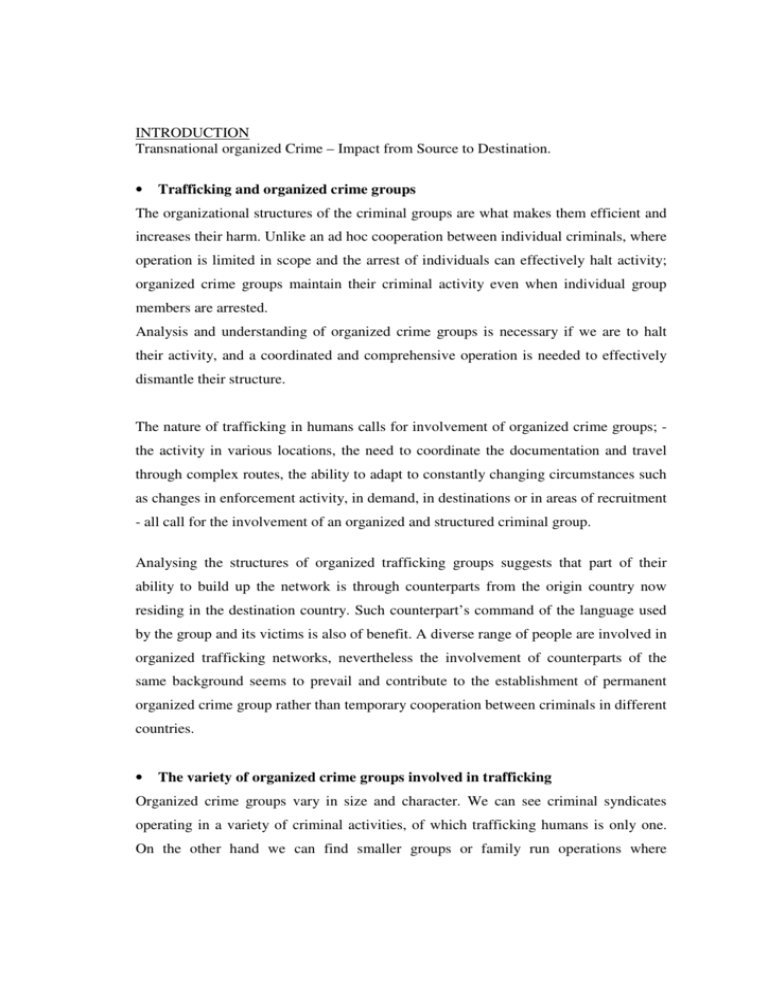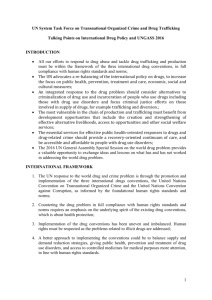INTRODUCTION Transnational organized Crime – Impact from
advertisement

INTRODUCTION Transnational organized Crime – Impact from Source to Destination. • Trafficking and organized crime groups The organizational structures of the criminal groups are what makes them efficient and increases their harm. Unlike an ad hoc cooperation between individual criminals, where operation is limited in scope and the arrest of individuals can effectively halt activity; organized crime groups maintain their criminal activity even when individual group members are arrested. Analysis and understanding of organized crime groups is necessary if we are to halt their activity, and a coordinated and comprehensive operation is needed to effectively dismantle their structure. The nature of trafficking in humans calls for involvement of organized crime groups; the activity in various locations, the need to coordinate the documentation and travel through complex routes, the ability to adapt to constantly changing circumstances such as changes in enforcement activity, in demand, in destinations or in areas of recruitment - all call for the involvement of an organized and structured criminal group. Analysing the structures of organized trafficking groups suggests that part of their ability to build up the network is through counterparts from the origin country now residing in the destination country. Such counterpart’s command of the language used by the group and its victims is also of benefit. A diverse range of people are involved in organized trafficking networks, nevertheless the involvement of counterparts of the same background seems to prevail and contribute to the establishment of permanent organized crime group rather than temporary cooperation between criminals in different countries. • The variety of organized crime groups involved in trafficking Organized crime groups vary in size and character. We can see criminal syndicates operating in a variety of criminal activities, of which trafficking humans is only one. On the other hand we can find smaller groups or family run operations where trafficking humans is the main ‘specialization’ and activity. Groups who are involved mainly in the demand side of trafficking can be identified too where activity is limited to buying and exploiting victims in the country of destination with no involvement in the recruitment and transport. Syndicate style organizations, seeking long term high profits may choose to invest in the trafficking process and conduct it from beginning to end, thus recruiting and transporting victims to be exploited in their own venues/businesses. Smaller organized crime groups are often limited to one part of the trafficking process, where profits are more immediate and a less complex organization is needed i.e. involvement only in the recruitment and selling of victims, or rather involvement only in the exploitation of trafficked victims. Trafficking occurs outside the definition of organized crime too, though in that case it usually involves individual or small numbers of victims. Diplomats, business people, people in need of care givers, etc. are all involved in recruiting, transporting and employing individuals. It is not uncommon for such arrangements to end with the exploitation of the vulnerable illegal employee, and in severe cases this amounts to trafficking in humans. • Thin line between organized crime and non-organized crime trafficking, and the variety within the organized crime definition. The line between what can be defined as an organized crime group and what can not is thin. A group consisting of a lawyer and a travel agent in the origin country, and an employment agent in the country of destination could qualify as organized crime group when they are involved in trafficking people for forced labour or domestic servitude, yet such an organized crime group is very different from the syndicate style organized crime organizations involved in trafficking, and each calls for different enforcement methods. • The importance of emphasising the link of trafficking to organized crime, where it exists In most legal systems placing a trafficker within a framework of an organized crime group will serve to emphasise the gravity of the crime and influence the legal reaction therefore. Defining a trafficking gang as an organized crime group suggests that the goal of law enforcement agencies it is not solely to disable individuals, but rather to disable the mechanism they are part of, thus generating a more rigorous response from law enforcement and the judiciary. Experience shows that when it is individuals who are targeted and not the mechanism they are part of itself - it is not uncommon for the trafficking to continue whilst the criminal is serving his sentence, with his indirect involvement or without it. • INTERPOL’s involvement through organized crime enforcement or THB INTERPOL’s projects on organized crimes spans the world. Starting from the traditional focus on the trafficking of drugs and weapons, the scope has gradually broadened over the last decade in response to the ever expanding involvement of criminal organizations in all forms of crime. Almost every reported organized crime group in Eurasia is involved in human trafficking, particularly for sexual exploitation, at some level. The main reason for that being the relatively low penalties and minimal infrastructure required. Large groups create international trafficking networks that stretch from small towns in eastern and central Europe where women are recruited, normally by means of deception (INTERPOL analytical report on Red Routes 2007), and all the way to brothels, nightclubs and streets throughout Europe, the Middle East and elsewhere in the world. In other parts of the world the same modus operandi is reported. Over the last year INTERPOL has received an increasing numbers of messages concerning trafficking of Asian women to Africa for sexual exploitation. Women recruited by means of deception into believing they were going to work in Europe, are finding themselves trafficked into Africa and ending up in brothels forced into prostitution. Transport is arranged by facilitators, and other counterparts meet the victims at the airport. Travel documents are take away from the women rendering them helpless as illegal migrants in a country unknown to them, where they have nowhere to turn to for help; in one case an Asian woman trafficked and locked up in a brothel for a few months reported that she was convinced she was in Europe for a long while, before one of her clients finally told her she was actually in Western Africa One of the last cases reported to INTERPOL just one week ago involves the trafficking of 100 women from Central Asia to the Gulf Countries. A group of 25 people, 10 men and 15 women were arrested for trafficking the women through Iran and in boats across the Persian Gulf. INTERPOL analyses found that quite often trafficking victims can turn traffickers themselves - becoming the recruiters of new victims (INTERPOL analytical report Red Routes 2007). This phenomenon is also illustrated in a case recently reported by Greece – where police say more and more victims turn into perpetrators and trafficking other women. This strategy on behalf of organized crime groups serves to distance other members from the direct involvement with new victims, thus making their prosecution harder in case the victims rescued. Involving victims in the trafficking also tighten the grip of the organized crime group over them, as they become accomplices to the crime and thus unlikely to turn against the network. These women are often sent to their hometowns – dressed up in high fashion and in possession of money – making luring and deception of other young women rather simpler and more effective. Organized crime will, as mentioned, always seek new ways to profit. In the area of human trafficking and exploitation INTERPOL and its member countries has identified the internet as an instrument which greatly facilitates trafficking of young girls. The dubious trend in online child sexual exploitation, which some have referred to as “legal child pornography,” has been steadily evolving and proliferating with relatively little interference from the police. The trend in question refers to preteen or child - “modeling” websites which operate in the gray zone between innocent imagery and child pornography. Although structure and approach varies from sites to site, most home pages of these so-called child model websites display images of a particular girl or a series of girls aged anywhere between 2 and 17 years. Unlike legitimate, conventional modeling agencies representing youth, these websites portray images of young girls nearly nude or in skimpy clothing, and frequently in sexually explicit poses. Depending on national legal definitions of child pornography, the producers of these websites are attempting to exploit, and with frightening success, the gaps between licit and illicit imagery. INTERPOL and Europol has in a recent case identified the links between one of these sites and sexually abusive images when the sexual abuse of a nine-year-old girl was discovered online and brought to the attention of INTERPOL’s Child Exploitation Unit. In time, the images were directly linked to a website supposedly promoting young “models.” The girl in question was not only proposed as a model, but the website furthermore advertised that she would be available for private photo sessions. This is a common occurrence on these sites. It was soon discovered that the photographer and owner of the “model” website had indeed sexually abused the young girl and subsequently posted numerous images of her abuse on the Internet. Investigation and operational police-support by INTERPOL to the national police services of the country concerned led to the rescue of this girl and the destruction of the criminal network led by the photographer and child abuser. Investigations are currently ongoing in many countries for other girls appearing on the child model website. Through the investigation of this case INTERPOL has found evidence that organized crime is indeed involved in the production of these websites. • Importance of cooperation between countries due to the nature of organized crime organizations involved in trafficking of humans. Organized criminals are adaptable, opportunistic and mobile. They transcend language barriers, ethnic differences and national borders in the pursuit of finical gain. Law enforcement has to be equally flexible through cooperation at the regional and global levels. Beside the exchange of expertise and intelligence on suspects and their modus operandi, law enforcement agencies must carry out more joint operations when only possible in order to render investigations and prosecutions more effective in dismantling all branches of the involved groups. In its position as the international organization of law enforcement agencies of 186 countries, INTERPOL serves as the main hub and resource for information regarding trafficking in humans, flowing from, between and to its member countries. INTERPOL’s systems support national law enforcement in identifying, locating and detaining people involved in trafficking. Through this involvement in the combat against trafficking world-wide INTERPOL is well aware of the existing gaps between the enforcement abilities of its different member countries. While some countries have developed expertise and experience in counter trafficking activity along the last years, other countries remain unaware and inexperienced in such law enforcement. It is this lack of experience and expertise which INTERPOL will seek to address in the near future, using the tools and experience it possesses. Three main areas for action can be identified as crucial keys for the successful combat of trafficking; Intervention at recruitment level, substantial and continuous investigation and prosecution, and lastly, but of high importance especially in cases involving organized crime groups – economic enforcement through seizure, taxation and any other tool available. The diverse illegal activities of organized crime groups drug trafficking, weapon smuggling, money laundering, corruption, trafficking in human beings, etc. – all feed into one another – facilitating and financing the commission of further and diverse crimes. Including economic enforcement as part of the prosecution of an organized crime group is vital to the prevention of its future recovery.









